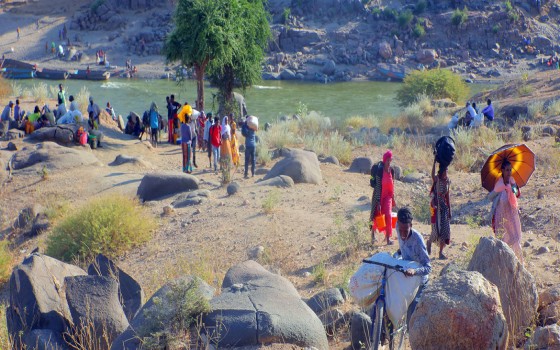
A terrifying phenomenon that threatens life... Prepared by Dr. Abdel Moneim Sedky, Professor at the Agricultural Research Center - Egypt

- Europe and Arabs
- Wednesday , 9 August 2023 11:29 AM GMT
From devastating floods in Pakistan to wildfires in Siberia, Tunisia, Algeria, Greece, France and Spain, the effects of climate change are being felt around the world. The world is facing a terrifying phenomenon that threatens life on Earth, which is the phenomenon of melting glaciers, which when melted in hot and dry seasons feed rivers, streams and water bodies.
glaciers
Huge, thick ice blocks formed on the land from snow falling during rainy seasons in very cold regions, which is compressed as a result of the extreme cold and slowly turns into layers or sheets of ice, where the earth retains a quantity of it for the following years. With the accumulation of snow, the weight of the upper layers increases, which pushes the ice crystals in the layers. The lower ones are compressed and begin to merge together and gradually increase in size until they turn into thick blocks of ice. The huge weight of the ice blocks at the bottom, with pressure due to the force of gravity, pushes these blocks to move slowly from the higher areas of the peaks towards the lower areas of the slopes, at varying speeds. From centimeters to several meters per year, and over hundreds of thousands of years, the accumulation of solid ice occurs in huge quantities, and huge solid rivers are formed that go slowly on their way to break up rocks, carve mountains, and cut valleys. The age of glaciers ranges from a few hundred to thousands of years, and most of the glaciers today are the remnants of the huge ice sheets that covered the Earth in the Ice Age more than 10,000 years ago. In order for the glacier to remain constant in size, there must be a balance between the annual accumulated snow and the melted or separated snow
Icebergs
Huge blocks of ice separated from the edges of a glacier moving sliding into the ocean water, which consists of frozen fresh water inside huge stones, sediment and gravel carried by the iceberg and travels long distances into the ocean. When the iceberg melts, its cargo settles at the bottom of the ocean and represents the phenomenon of icebergs in the presence of fog. A natural hazard to ships sailing in those areas.
Glacier location
Glaciers are not limited to the Arctic continent, but are found all over the world. In Ecuador, Kenya, Uganda, New Guinea, Argentina, Alaska, New Zealand, Denmark, Greenland, Canada, Pakistan and China, glaciers are found at or near the equator.
The importance of glaciers
• Ice acts as a protective blanket for the land and oceans as it reflects excess heat back into space and keeps the planet cool.
• Glaciers contain huge quantities of fresh water, up to 80% of the fresh water on the surface of the globe
• They act as giant reservoirs that trap the falling water in the form of snow, to release it in the form of melt water in dry and hot seasons. This ensures a constant supply of water throughout the year.
• Melting glaciers provide nutrients to lakes, rivers and oceans, which leads to the preservation of habitats for plants and animals.
• People who live in arid climates near mountains often depend on melting ice for water for part of the year, such as the Himalayan people in the Andes, who depend a lot on glacial water.
• Generation of hydroelectric power from melt water.
• Glaciers are an important indicator for detecting climate changes in their decline, growth, or progression, which enables researchers to monitor changes in temperature and precipitation, and determine the rise in sea levels by measuring the loss of ice in glaciers, and the relationship here is direct between the melting of glaciers and the rise in sea levels .
melting glaciers
Glaciers provide an important part of the fresh water consumed by humans. Glaciers are shrinking at a high rate as a result of climate change, losing about 58 billion tons of ice annually. When glaciers melt rapidly, millions of people face water scarcity and increased risks of natural disasters such as floods, and millions more may be displaced by rising sea levels.
Since the early 20th century, many glaciers around the world have been melting rapidly due to human activities. Specifically since the Industrial Revolution, the rise in carbon dioxide and other greenhouse gases has caused the Earth's temperature to rise 1.1 °C above pre-industrial levels. As a result, the glaciers are melting. quickly. Scientists predict that if greenhouse gas emissions continue to rise, the Arctic could be free of summer ice by 2040. Glaciers are trying to adapt to rising temperatures by melting at a steady pace, causing the glacier to shrink and sea levels to rise, leading to In turn, increased coastal erosion and increased storms, as the rise in air and ocean temperatures leads to more frequent and intense floods, storms, and coastal hurricanes. Ice lakes adjacent to glaciers are filled, overflowing their banks, and causing catastrophic floods downstream, as happened in Pakistan at the end of 2022. The number of glaciers in it exceeds 7,200 glaciers, which are now vulnerable to melting due to the rise in global temperatures, and this was evident in the floods that led to the drowning of a third of the area of Pakistan after the country was exposed to a wave of severe monsoon rains that pushed streams and rivers filled with water coming from the glaciers dissolved, to floods.
The melting of ice in both the North and South Poles contributes to the phenomenon of global warming due to the presence of large amounts of carbon stored in the ice, and after the melting of this ice with many factors such as forest fires, volcanic eruptions and solar activity, gases are released in a large way
And when carbon is suddenly emitted, it will cause a disruption in natural processes, such as the carbon cycle, because the source of carbon stored in ice is from outside the atmosphere thousands of years ago. The glacier at the top of Mount Kilimanjaro has shrunk rapidly in the century leaving only 18% of its volume and is still declining today. The Aletsch River, which is the largest glacier in the Alps, and the longest glaciers in Switzerland, which is 23 km long, 900 m thick, and carries 11 billion tons of ice. The longest glaciers in the world. Half of the glaciers could disappear by 2100 if greenhouse gas emissions continue at the current rate.
The factors of melting glaciers are due to the scarcity of snowfall during the winter season and the blowing of the sands of the Sahara Desert in February, which is deposited on ice and snow and reduces the effect of albedo in addition to heat waves. This melting causes natural disasters such as floods, debris flows and landslides, and the lakes that will form inside the glaciers begin to flow towards the plains and valleys, sweeping away villages and infrastructure on their way. As the ice and permafrost continue to thin, the mountains become less solid and stable.
It is imperative that more investment is now made in nature-based solutions, which can help mitigate climate change and allow for better adaptation to its impacts to help countries adapt to an increasingly unstable environment.












No Comments Found